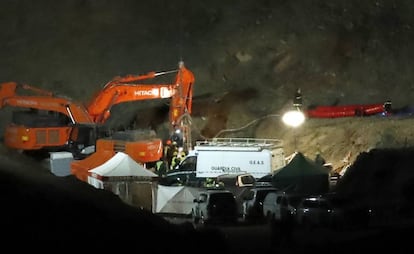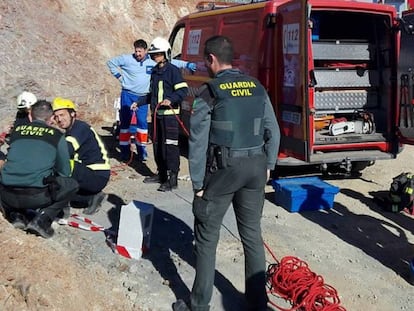Spanish toddler died from fall into shaft, not rescuer’s pickaxe: autopsy
The sole suspect in the death of two-year-old Julen Roselló last January claimed that the child could have been accidentally killed by firefighters

A Spanish toddler who slipped into a borehole in southern Spain in January died from the fall and not from an accidental blow to the head by a rescuer’s pickaxe, a definitive autopsy has confirmed.
Julen Roselló fell into a deep, narrow opening on a relative’s property in Totalán (Málaga) on January 13, triggering an unprecedented 13-day rescue operation by 300 people, including firefighters, engineers, explosives experts and an elite mining unit.
The child’s head was injured in two places: at the base of the skull, and on the left side
Rescuers worked round the clock, using heavy machinery to dig a parallel shaft beside the borehole, which was only 25cm wide, and then tunneling across through hard rock. The search ended on January 26 when rescuers located the body at a depth of around 71 meters.
“The fundamental cause of death was the fall,” says a report drafted after the final autopsy was conducted. Judicial sources said that the little boy died at around 1.50pm on the same day that he fell into the borehole, which had been dug illegally in search of water. According to the report, his survival time “was short.”
Pickaxe theory

The report debunks the theory upheld by the defense lawyers for the only individual under investigation for involuntary manslaughter: David Serrano, the owner of the property where the accident took place.
Serrano’s defense had claimed that Julen could have been killed by an accidental blow from a pickaxe used by firefighters in the early stages of the rescue operation, when they were still trying to extract a plug of earth from inside the borehole in a bid to pull out the child.
The four doctors who signed the 25-page report said that the boy’s head was injured in two places: at the base of the skull, and on the left side, from the effects of a blow from a projecting element along the inner walls of the shaft, which had not been lined.
The medical report underscores that no fractures were found at the top of the skull, and that the injury on the side of the head could not have been made by a pickaxe thrown down from a height of 70 meters.
The uneven surface and friction from the child’s clothes slowed down the fall. This, and the natural elasticity of the young child’s body, explains why the post-mortem examination did not show not more fractured bones.
At a press conference in early February, David Serrano said that he had covered the hole with two concrete blocks at 1pm on January 13 – just before the toddler fell down the shaft. Serrano also maintained that he had warned people in the area about the opening. “I thought someone’s foot could slip in and break, but I never thought a child would fit inside,” he said.
English version by Susana Urra.
Tu suscripción se está usando en otro dispositivo
¿Quieres añadir otro usuario a tu suscripción?
Si continúas leyendo en este dispositivo, no se podrá leer en el otro.
FlechaTu suscripción se está usando en otro dispositivo y solo puedes acceder a EL PAÍS desde un dispositivo a la vez.
Si quieres compartir tu cuenta, cambia tu suscripción a la modalidad Premium, así podrás añadir otro usuario. Cada uno accederá con su propia cuenta de email, lo que os permitirá personalizar vuestra experiencia en EL PAÍS.
¿Tienes una suscripción de empresa? Accede aquí para contratar más cuentas.
En el caso de no saber quién está usando tu cuenta, te recomendamos cambiar tu contraseña aquí.
Si decides continuar compartiendo tu cuenta, este mensaje se mostrará en tu dispositivo y en el de la otra persona que está usando tu cuenta de forma indefinida, afectando a tu experiencia de lectura. Puedes consultar aquí los términos y condiciones de la suscripción digital.
More information
Archived In
Últimas noticias
Most viewed
- Reinhard Genzel, Nobel laureate in physics: ‘One-minute videos will never give you the truth’
- Oona Chaplin: ‘I told James Cameron that I was living in a treehouse and starting a permaculture project with a friend’
- Pablo Escobar’s hippos: A serious environmental problem, 40 years on
- Why we lost the habit of sleeping in two segments and how that changed our sense of time
- Chevy Chase, the beloved comedian who was a monster off camera: ‘Not everyone hated him, just the people who’ve worked with him’











































